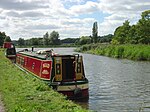Milford and Brocton railway station
1877 establishments in EnglandDisused railway stations in StaffordshireFormer London and North Western Railway stationsPages with no open date in Infobox stationRailway stations in Great Britain closed in 1950 ... and 3 more
Railway stations in Great Britain opened in 1877Use British English from June 2017West Midlands (region) railway station stubs

Milford and Brocton railway station served the villages of Milford and Brocton in Staffordshire, England from 1877 to 1950 on the Trent Valley line.
Excerpt from the Wikipedia article Milford and Brocton railway station (License: CC BY-SA 3.0, Authors, Images).Milford and Brocton railway station
Holdiford Road,
Geographical coordinates (GPS) Address Nearby Places Show on map
Geographical coordinates (GPS)
| Latitude | Longitude |
|---|---|
| N 52.7893 ° | E -2.04 ° |
Address
Holdiford Road
Holdiford Road
ST17 0UX , Berkswich
England, United Kingdom
Open on Google Maps







